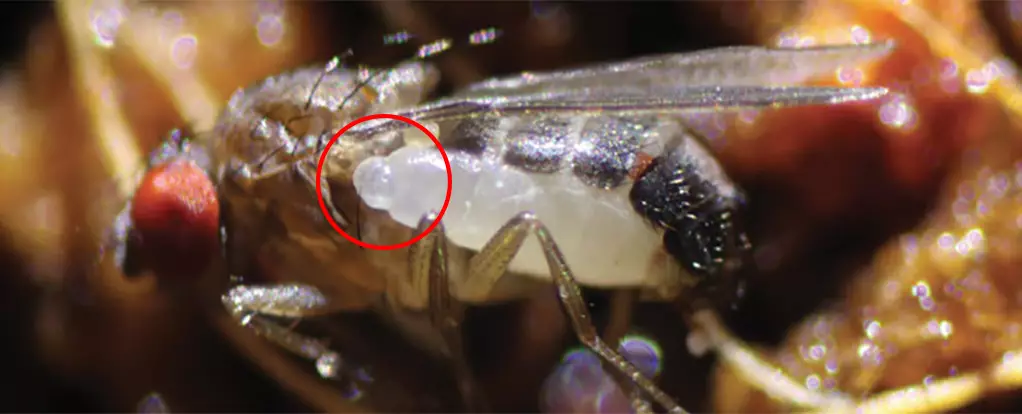In a remarkable twist of nature, biologists have unveiled a previously unknown species of wasp—Syntretus perlmani—nestled within the very anatomy of an adult fruit fly. This discovery raises profound questions about the adaptability and ecological niches exploited by parasitoid wasps. Unlike countless other parasitoid wasps that have been documented targeting the juvenile stages of various insects, Syntretus perlmani has managed to carve a niche within the uncharted territory of adult Drosophila flies. The notion that a wasp can survive and develop within the abdomen of a fully grown fly is staggering and challenges our understanding of host-parasite dynamics.
The team’s foray into this peculiar world began with a seemingly standard collection mission initiated in March 2023 in Mississippi. While pursuing nematode infections among fruit flies, the researchers instead encountered an astonishing inhabitant—a larval wasp thriving within the flesh of an adult male Drosophila. This chance discovery immediately suggested that they were dealing with a species of Syntretus not previously documented. Over the ensuing eleven months, a thorough investigation drove the researchers to collect over 6,000 male flies from neighboring states, tracking the prevalence of this unique wasp larvae. Shockingly, less than 1 percent of the flies across this expansive collection tested positive for parasitism, with fluctuating rates throughout the year.
This low infection rate challenges biologists to rethink the prevalence and survival strategies of not only Syntretus perlmani but other parasitoid wasps that rely on specific hosts. Collectively, the data presents an intriguing puzzle: What makes the adult Drosophila flies such an attractive yet rare host for this species? What are the evolutionary implications of targeting adult hosts, which may pose unique immune responses compared to larvae?
The Lifecycle of Syntretus perlmani: A Gruesome Transformation
Delving deeper into the lifecycle of Syntretus perlmani reveals an astonishing array of adaptations that facilitate its survival. Once an egg is deposited in its host, the larva undergoes approximately 18 days of development while the Drosophila remains active. The larva’s remarkable ability to manipulate its host’s physiology allows it to thrive within the confines of its abdomen, leading to its eventual emergence through a rather macabre process. Just as a “chestburster” scene from a science fiction film, the larva eventually chews its way out of the Drosophila, showcasing not only its predatory instincts but also the harsh realities of evolutionary survival.
For the Drosophila, this parasitism presents a dire situation, as the hosts become victims of their own biology. However, the tale does not end there. Within a mere 24 hours of emerging, the female wasps begin reproducing, bolstering their ranks and perpetuating a relentless lifecycle. The relentless cycle of predation unfolds before our eyes, exemplifying the fierce competition for survival in nature.
The researchers assert that this newfound wasp species not only broadens our understanding of parasitoid wasp biology but also serves as an ideal candidate for future biological studies. Given its prevalence in backyard settings across east-central USA, Syntretus perlmani presents a unique opportunity for researchers to explore various topics ranging from immunity and ecology to behavior and metabolism.
Additionally, the wasp’s interaction with Drosophila melanogaster, one of the most extensively studied organisms in genetics, paves the way for interesting new avenues in life sciences research. The potential for insights regarding evolutionary biology, host-parasite relationships, and ecological dynamics becomes immensely exciting with such a model organism at the core.
In summation, the discovery of Syntretus perlmani adds another layer to the intricate web of life, illuminating our understanding of parasitoid relationships and insect behavior within the complex ecosystem. As biologists shed light on such enigmatic organisms, they unravel not just biological mysteries but also the underlying principles of survival in the animal kingdom. As the research continues, this wasp may pave the way for significant advancements in our knowledge of ecology, evolution, and the interconnectedness of life itself.


Leave a Reply